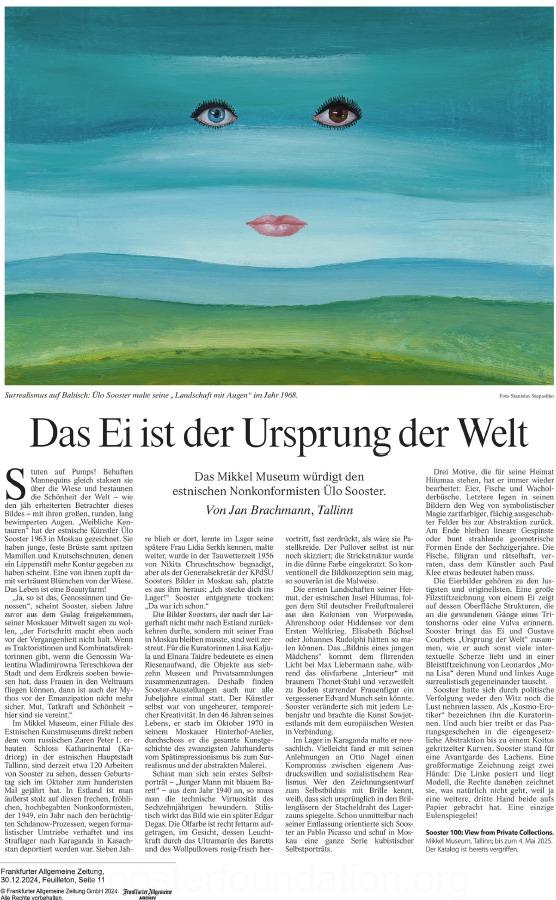"The Egg is the origin of the Universe"
The Estonian artist Ülo Sooster was a witty nonconformist in 20th-century art. Even under Soviet rule, he remained unbroken, even in the camps. The Mikkel Museum in Tallinn honors him on his 100th birthday.

Mares in high heels! Like hoofed mannequins, they prance across the meadow, marveling at the beauty of the world—with their large, round, and long-lashed eyes—as does the suddenly amused viewer of this image. The Estonian artist Ülo Sooster drew these "Female Centaurs" in Moscow in 1963. They have youthful, firm breasts with pointed nipples and pouty lips that seem to have been given extra definition by lipstick. One of them dreamily plucks flowers from the meadow. Life is a beauty farm!
“Yes, comrades,” Sooster—who had been freed from the Gulag seven years earlier—seems to tell his Moscow contemporaries, “progress doesn’t stop, not even for the past. If we have female tractor drivers and factory directors, if Comrade Valentina Tereshkova has just proven to the city and the world that women can fly into space, then even mythology is not safe from emancipation. Courage, determination, and beauty—here they are united.”
In Estonia, Ülo Sooster is a Source of Great Pride
At the Mikkel Museum, a branch of the Estonian Art Museum located near Kadriorg Palace in Tallinn (built by Russian Tsar Peter I), approximately 120 works by Sooster are currently on display. His 100th birthday was celebrated this October. Estonia takes immense pride in this cheeky, joyful, and extraordinarily talented nonconformist, who was arrested in 1949—a year after the infamous Zhdanov trials—for formalist activities and deported to a labor camp in Karaganda, Kazakhstan.
He remained in the camp for seven years, where he met his future wife, Lidia Serkh, continued painting, and was pardoned during Khrushchev’s thaw in 1956. But when the General Secretary of the CPSU saw Sooster’s works in Moscow, he blurted, “I’ll send you to the camps!” Sooster dryly replied, “I’ve already been.”
Sooster's works, which were not allowed to return to Estonia after his release, were scattered around. For curators Liisa Kaljula and Elnara Taidre, it was a huge task to collect exhibits from 17 museums and private collections. Therefore, Sooster's exhibitions are very rare.
Sooster's work was incredibly intense and rapid. In his 46 years – he died in October 1970 in his courtyard studio in Moscow – he went through the entire history of 20th-century art: from late impressionism to surrealism and abstract painting.

His first self-portrait, "Young Man in a Blue Beret" (1940), reveals the technical virtuosity of a 16-year-old. Stylistically, it resembles Edgar Degas. The oil paint is applied sparingly; on the face, its luminosity—enhanced by the ultramarine beret and sweater—appears almost like pastel. The sweater itself is only sketched, with the knitted texture scratched into the thin paint. While the composition is conventional, the execution is masterful.
Early landscapes from his homeland, the Estonian island of Hiiumaa, follow the style of German plein air painting from Worpswede, Ahrenshoop, or Hiddensee before World War I. The Portrait of a Young Girl evokes Max Liebermann’s shimmering light, while the olive-toned Interior with a Thonet chair and a despairing female figure recalls Edvard Munch. Sooster evolved with every year of his life, connecting Soviet Estonian art with the European West.
Painting in the Prison Camp
In Karaganda, Sooster painted in the style of New Objectivity (Neue Sachlichkeit), possibly finding a compromise between his artistic vision and Socialist Realism through influences like Otto Nagel. A draft of his self-portrait shows barbed wire reflected in the glasses, a stark reference to the camp fences. After his release, Sooster turned to Pablo Picasso, producing a series of Cubist self-portraits in Moscow.
Iconic Motifs
Sooster often returned to three motifs representing his homeland: eggs, fish, and junipers. In his works, junipers transform from symbolist magic in softly colored fields to abstraction, ending as linear webs or radiant geometric forms in the late 1960s.
The fish, delicate and enigmatic, suggest that Paul Klee influenced him. The egg images, among his most humorous and original, include a large marker drawing depicting an egg with surface patterns reminiscent of a triton’s shell or a vulva. Sooster merges the egg with Gustave Courbet’s The Origin of the World, reflecting his fondness for intertextual humor, as seen in a surreal pencil sketch swapping the mouth and left eye of Leonardo’s Mona Lisa.
A “Cosmo-Eroticist”
Political persecution never robbed Sooster of his wit or joy. Curators call him a “cosmo-eroticist,” pointing to his abstraction of mating scenes into scribbled curves. Sooster stood for an avant-garde of laughter. One large drawing depicts two hands—one posing, the other drawing it. The impossibility of the scene—a third hand must have created the image—is a mischievous visual pun.
Exhibition: Sooster 100: View from Private Collections, Mikkel Museum, Tallinn, through May 4, 2025. The catalog has already sold out but will be reprinted due to high demand. —Jan Brachmann, Culture Editor
Von Jan BrachmannTallinn 30.12.2024